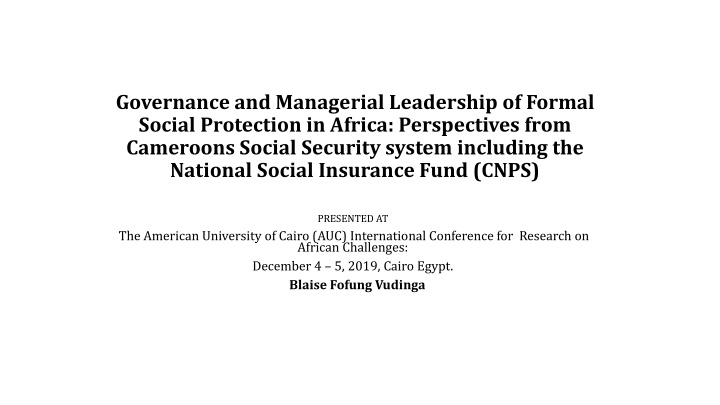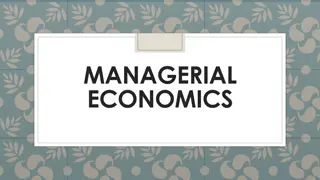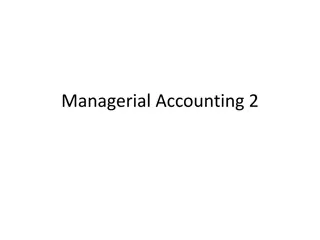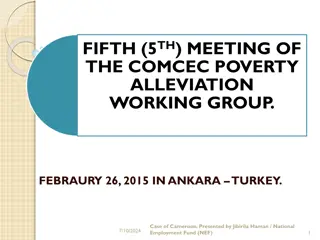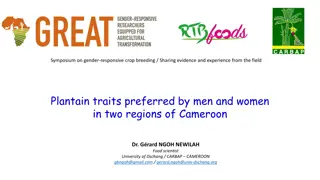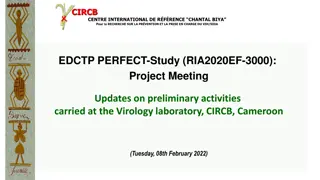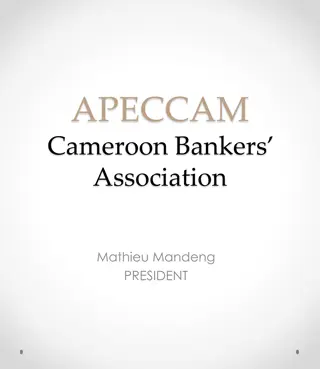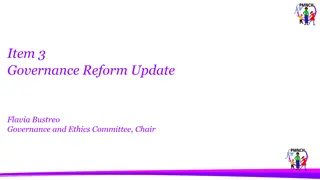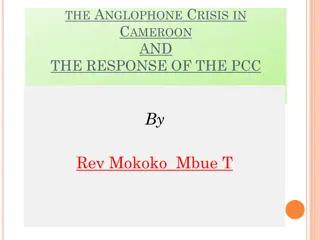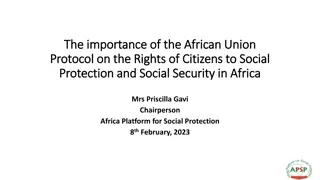Governance and Managerial Leadership of Formal Social Protection in Africa: Insights from Cameroon's National Social Insurance Fund (CNPS)
This presentation delves into the governance and managerial leadership of formal social protection in Africa, focusing on Cameroon's CNPS system. It discusses the institutional evolution of social protection, the challenges faced by bureaucratic and political stakeholders, and the roles of various stakeholders in shaping social protection policies. The evolution of formal social protection in Cameroon from 1952 to 1977 is examined, highlighting key laws and schemes that laid the foundation for the current system.
Download Presentation

Please find below an Image/Link to download the presentation.
The content on the website is provided AS IS for your information and personal use only. It may not be sold, licensed, or shared on other websites without obtaining consent from the author.If you encounter any issues during the download, it is possible that the publisher has removed the file from their server.
You are allowed to download the files provided on this website for personal or commercial use, subject to the condition that they are used lawfully. All files are the property of their respective owners.
The content on the website is provided AS IS for your information and personal use only. It may not be sold, licensed, or shared on other websites without obtaining consent from the author.
E N D
Presentation Transcript
Governance and Managerial Leadership of Formal Social Protection in Africa: Perspectives from Cameroons Social Security system including the National Social Insurance Fund (CNPS) PRESENTED AT The American University of Cairo (AUC) International Conference for Research on African Challenges: December 4 5, 2019, Cairo Egypt. Blaise Fofung Vudinga
Summary of Presentation Introduction: - What is formal social protection/stakeholders? - Who are these policy and managerial SP stakeholders? Institutional Evolution of formal Social Protection. Managerial challenges faced by both Bureaucratic and Political SP Leadership(stakeholders). CNPS Management and its Challenges. Summary and Conclusions
What is formal Social Protection and who are the SP Stakeholders? A the set of policies and programs designed to reduce and prevent poverty and vulnerability across the life cycle in nine main areas: child and family benefits, maternity protection, unemployment support, employment injury benefits, sickness benefits, health protection, old- age benefits, disability benefits and survivors benefits through a mix of contributory schemes (social insurance) and non-contributory tax financed social assistance (ILO, 2017:2). These are people who occupy influential positions in relation to social protection policies and their understanding and values drive the social protection agenda in Cameroon. Social protection stakeholders are divided into two groups bureaucratic and non-bureaucratic (political) and their roles are developed and institutionalized differently and operate at a range of levels
Institutional Evolution of formal Social Protection.(1952-1977) Grounded on 1952 Labour code creating Family Allowance Fund adopted by expatriates in order to support French citizens who were employed within the private sector. This formal system evolved into the Equalization Fund for Family Benefits, which covered all workers in the private sector. These comprise Law No. 67-LF-07 of 12 June 1967 which established a family benefits code. Law No. 67-LF-08 of 12 June 1967 which established the Cameroon National Social Insurance Fund (CNPS) as an independent body in charge of managing social benefits scheme. Law No. 69-LF-18 of 10 November 1969 which instituted an old-age, invalidity and death pensions insurance scheme. Ordinance No. 73-17 of 22 May 1973 on the organization of social insurance, which entrusts to the CNPS, as part of government s policy, the service of various benefits provided by the legislation of social protection. Law No. 77-11 of 13 July 1977 on the compensation and prevention of industrial accidents and occupational diseases that entrusts to the CNPS coverage and management of occupational risks.
Managerial challenges faced by both Political and Bureaucratic SP Leadership(stakeholders). Political Stakeholders Problem solving and agenda setting: Relatively limited in setting agendas and suggesting solutions. They can not propose concrete agendas. Highly centralized governance structure (Parliament). Lack of political will: Especially from executive and governmental leadership. This is a big barrier. Strategic gaps: lack of strategic thinking: Better targeting of vulnerable people. Have very broad ideas about issues of vulnerability. Underdeveloped concepts and frameworks: lack the ability to conceptualize issues of risk and vulnerability, Lack of shared principles leading to the use of excessive discretionary powers when managing SP resources.
Managerial challenges faced by both Political and Bureaucratic SP Leadership(stakeholders). Bureaucratic Stakeholders. Legislative and Policy weaknesses:Too much emphasis on legislative formulation and statutory statements. Non-compliance and non-enforceability Resource constraints: Finance and budget setting, HR problems e.g. staffing, skills and training, Corruption and fraud. Citizenship Knowledge and awareness: Lack of knowledge about rights and obligations Lack of concepts and frameworks: Implementation gaps, Institutional tensions and Lack of collaboration.
CNPS Management and its Challenges Allegations of large scale corruption. Questions about levels of autonomy and largely centralised policies and agenda. Long lasting delivery and administrative issues. Adhoc and pacthwork improvementlately?
Summary and Conclusion The paper gives significant insights into the managerial and leadership challenges facing both political and bureaucratic SP stakeholders in an African setting. SP key stakeholders are faced with structural and contextual managerial challenges hindering the development of viable social protection framework systems. There is need to further understand how key political stakeholders think about the management of social protection. It is crucial to enhance the capacity of bureaucratic stakeholders who are involved in the daily management of social protection institutions in order to lead to the attainment of a robust social protection framework. Thank you !!!
